
London Docklands is the riverfront and former docks in London. It is located in inner east and southeast London, in the boroughs of Southwark, Tower Hamlets, Lewisham, Newham, and Greenwich. The docks were formerly part of the Port of London, at one time the world's largest port. After the docks closed, the area had become derelict and poverty-ridden by the 1980s. The Docklands' regeneration began later that decade; it has been redeveloped principally for commercial and residential use. The name "London Docklands" was used for the first time in a government report on redevelopment plans in 1971 and has since been almost universally adopted. The redevelopment created wealth, but also led to some conflict between the new and old communities in the area.

Bermondsey is a district in South East London in the London Borough of Southwark, England, 2.5 miles (4.0 km) southeast of Charing Cross. To the west of Bermondsey lies Southwark, to the east Rotherhithe and Deptford, to the south Walworth and Peckham, and to the north is Wapping across the River Thames. It lies within the historic county boundaries of Surrey.

The London Borough of Southwark in south London forms part of Inner London and is connected by bridges across the River Thames to the City of London and London Borough of Tower Hamlets. It was created in 1965 when three smaller council areas amalgamated under the London Government Act 1963. All districts of the area are within the London postal district. It is governed by Southwark London Borough Council.
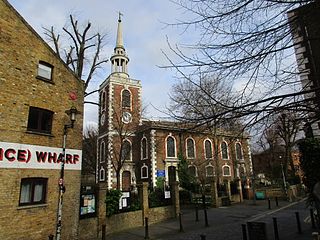
Rotherhithe is a residential district in south-east London, England, and part of the London Borough of Southwark. Historically the area was the most northeastern settlement in the county of Surrey. It is located on a peninsula on the south bank of the Thames, facing Wapping and Limehouse on the north bank, and is a part of the Docklands area. It borders Bermondsey to the west and Deptford to the south east.

Surrey Quays is a station on the East London Line branch of the London Overground. It is located in Rotherhithe, part of London Borough of Southwark. It is in Zone 2 and the next station to the north is Canada Water, and to the south it splits into branches to Clapham Junction, New Cross and Crystal Palace/West Croydon. Closed in late 2007, the station was refurbished and re-opened as part of the London Overground network on 27 April 2010.

Surrey Docks is a largely residential area of Rotherhithe in south-east London, occupied until 1970 by the Surrey Commercial Docks. The precise boundaries of the area are somewhat amorphous, but it is generally considered to comprise the southern half of the Rotherhithe peninsula from Canada Water to South Dock; electorally, Surrey Docks is the eastern half of the peninsula. The area is served by Surrey Quays railway station. The Docks are called Surrey Docks because until 1889 the borders of Surrey and Kent met in this area.
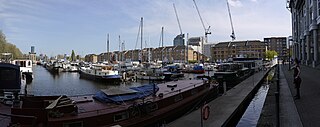
Greenland Dock is the oldest of London's riverside wet docks, located in Rotherhithe in the area of the city now known as Docklands. It used to be part of the Surrey Commercial Docks, most of which have by now been filled in. Greenland Dock is now used purely for recreational purposes; it is one of only two functioning enclosed docks on the south bank of the River Thames, along with the smaller South Dock, Rotherhithe, to which it is connected by a channel now known as Greenland Cut.
South Dock is one of two surviving docks in the former Surrey Commercial Docks in Rotherhithe, London, England. It was built in 1807–1811 just south of the larger Greenland Dock, to which it is connected by a channel now known as Greenland Cut; it also has a lock giving access to the River Thames. Originally named the East Country Dock, it was renamed in 1850 when the Surrey Commercial Dock Company purchased and enlarged it. Timber and grain were the main products imported and exported in the dock.

Canada Water is an area of the Docklands in south-east London. It is named after a freshwater lake and wildlife refuge. Canada Water tube, Overground and bus station is immediately north of the lake, along with Canada Water Library which overhangs the lake and Deal Porter Square. Surrey Quays Shopping Centre is also adjacent, sitting immediately to the south. The surrounding area, which forms the town centre of Rotherhithe, is now increasingly known as Canada Water, after the transport interchange as much as the lake itself.
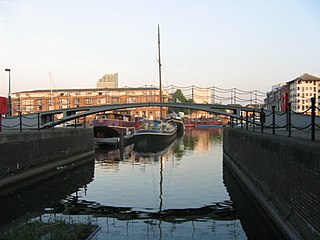
The Grand Surrey Canal was a canal constructed in south London, England during the early 19th century. It opened to the Old Kent Road in 1807, to Camberwell in 1810, and to Peckham in 1826. Its main purpose was to transport cargo, primarily timber from the Surrey Commercial Docks.

Russia Dock Woodland is a long narrow park in Rotherhithe, London, created by the infilling of one of the former Surrey Commercial Docks. The former Russia Dock was originally used for the importing of softwood timber from Norway, Russia and Sweden. Known as "deal wood", it was mostly used for newsprint and for manufacturing furniture.

Bermondsey and Old Southwark is a constituency in the House of Commons of the UK Parliament. Since 2015, it has been represented by Neil Coyle of the Labour Party.
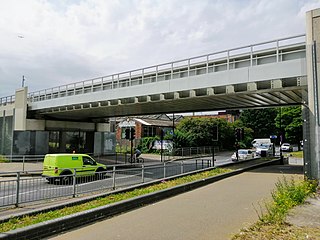
New Bermondsey railway station is a planned railway station with permission granted on the South London Line of the London Overground network. It will be on the branch from Surrey Quays to Clapham Junction with through trains every 15 minutes between Clapham Junction and Highbury & Islington. The station site is on Surrey Canal Road at the district boundary of Bermondsey, New Cross and Deptford. The station will be adjacent to Millwall Football Club's ground and would help ease the burden of match-day crowds on the nearby South Bermondsey railway station and Surrey Quays Station.

St Olave's Church, Southwark was a church in Southwark, England which is believed to be mentioned in the Domesday Book. It was located on Tooley Street which is named after the church, i.e. 't'olous'. It became redundant in 1926 and was demolished. It is now the location of St Olaf House, which houses part of the London Bridge Hospital.
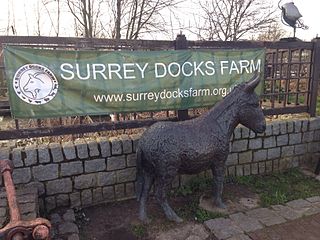
Surrey Docks Farm is a working city farm in the heart of London. It occupies a 2.2-acre (8,900 m2) site on the south bank of the River Thames in Rotherhithe.
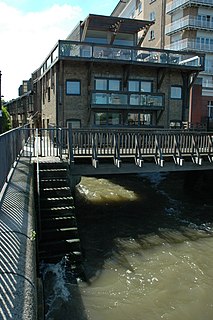
Odessa Wharf is an early 19th-century warehouse located on the south bank of the River Thames at Rotherhithe, London. The warehouse has been converted into apartments and townhouses, some of which are operated as holiday lets by Odessa Club Management with the remainder as private residences. It is situated directly on the Thames Path national trail, north of Greenland Dock, with distinctive timber box "lanterns" on its roof.

Lavender Pond is a 2.5 acre local nature reserve in Rotherhithe in the London Borough of Southwark. It is owned by Southwark Council and managed by The Conservation Volunteers. The nature reserve has an area of woodland as well as the pond.
Surrey Quays Shopping & Leisure is located in Rotherhithe, London. It is currently owned by British Land.
Surrey Docks North was an authorised underground railway station planned by London Underground but never built. It was to be located in Rotherhithe and named after the Surrey Commercial Docks in the London Borough of Southwark, in east London as a station on an unbuilt extension of the Jubilee line to Woolwich Arsenal.
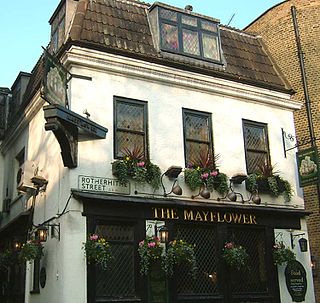
Rotherhithe Street is a road in the London Borough of Southwark on the Thames Path. At a length of around 1.5 miles (2.4 km), it is one of the longest street in London. Notable buildings on the street include the Grade II* listed Nelson House, St Mary's Church, Rotherhithe and Surrey Docks Farm.




















